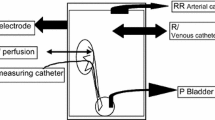Summary
The interaction of metoclopramide with renal dopamine receptors has been characterized in anesthetized dogs surgically prepared with arterial blood pressure catheters and renal artery blood flowprobes.
In normal dogs, i. v. dopamine (3 μg/kg) produced consistent and selective decrements in renal vascular resistance (RVR) and increments in renal blood flow over a 220 min test period; mean arterial blood pressure and cardiac rate were minimally affected. Pretreatment with metoclopramide, 1 and 10 mg/kg i. v., resulted in dose-related inhibition (maximum inhibition 44% and 94%, respectively) of the renal vasodilator activity of dopamine without altering baseline parameters. The duration of antagonism produced by 1 mg/kg of metoclopramide was approximately 30 min, while 10 mg/kg resulted in significant attenuation for the entire test period. Decreases in RVR produced by prostaglandin A1 (0.03 and 0.3 μg/kg, i. v.) and bradykinin (3 and 15 μg/kg, i. v.) that were comparable to those of dopamine were unaltered by metoclopramide. Furthermore, metoclopramide did not affect the diastolic blood pressure responses to noradrenaline (0.1–3 μg/kg, i. v.) or isoproterenol (0.03–0.3 μg/kg, i. v.), nor did it alter dopamine-induced vasoconstriction of the iliac vasculature.
In phenoxybenzamine (3 mg/kg, i. v.) treated dogs, dopamine (0.3–30 μg/kg, i. v.) produced dose-related reductions in RVR. Administration of metoclopramide (10 mg/kg, i. v.) resulted in a 10-fold parallel displacement, to the right, of the RVR dose-response curve to dopamine.
These findings demonstrate that metoclopramide is an effective antagonist of renal dopamine receptors following systemic administration in the dog. The results are not consistent with the classification of metoclopramide as a selective antagonist of D-2 receptors.
Similar content being viewed by others
References
Ahtee L, Buncombe G (1974) Metoclopramide induces catalepsy and increases strial homovanillic acid content in mice. Acta Pharmacol Toxicol 35:429–432
Costall B, Naylor RJ (1973a) Neuroleptic and non-neuroleptic catalepsy. Arzneim Forsch 23:674–683
Costall B, Naylor RJ (1973b) Is there a relationship between the involvement of extrapyramidal and mesolimbic brain areas with the cataleptic action of neuroleptic agents and their clinical antipsychotic effect? Psychopharmacologia (Berlin) 32:161–170
Day MD, Blower PR (1975) Cardiovascular dopamine receptor stimulation antagonized by metoclopramide. J Pharm Pharmacol 27:276–278
Dougan DFH, Mearrick PT, Wade DN (1974) Metoclopramide as a dopamine antagonist in the heart and gut of the mollusc Tapes watlingi. Clin Exp Pharmacol Physiol 1:473–478
Goldberg LI, Volkman PH, Kohli JD (1978) A comparison of the vascular dopamine receptor with other dopamine receptors. Annu Rev Pharmacol Toxicol 18:57–79
Hackman R, Pentikainen P, Neuvonen PJ, Vapaatalo H (1973) Inhibition of the apomorphine gnawing compulsion by amphetamine. Experientia 34:1524–1525
Higgins CB, Millard RW, Braunwald E, Vatner SF (1973) Effects and mechanisms of action of dopamine on regional hemodynamics in the conscious dog. Am J Physiol 225:432–437
Janssen PAJ, Niemegeers CJF, Schellekens KHL, Lenaerts FM (1967) Is it possible to predict the clinical effects of neuroleptic drugs (major tranquilizers) from animal data? Arzneim Forsch 17:841–854
Justin-Besancon L, Laville C (1972) Action anti-emetique du metoclopramide vis-a-vis de l'apomorphine et du l'hydergine. C R Soc Biol (Paris) 158:723–727
Kebabian JW, Calne DB (1979) Multiple receptors for dopamine. Nature 277:93–96
Klein RL, Militello TE, Ballinger CM (1968) Anti-emetic effect of metoclopramide. Evaluation in humans. Anesthesia and Analgesia 47:259
Kohli JD, Volkman PH, Glcok D, Goldberg LI (1978) Metocloprmaide and sulpiride: Antagonists of the vascular dopamine receptor. Fed Proc 37:729
Langer SZ (1977) Presynaptic receptors and their role in the regulation of transmitter release. Br J Pharmacol 60:481–497
Langer SZ, Dubocovich ML (1979) Physiological and pharmacological role of the regulation of noradrenaline release by presynaptic dopamine receptors in the peripheral nervous system. In: Imbs J, Schwartz J (eds) Peripheral dopaminergic receptors, Pergamon Press, New York, pp 233–245
Lokhandwala MF, Jandhyala BS (1979) The role of sympathetic nervous system in the vascular actions of dopamine. J Pharmacol Exp Ther 210:120–126
McNay JL, McDonald RH, Goldberg LI (1965) Direct renal vasodilation produced by dopamine in the dog. Circ Res 16:510–517
Olsen UB (1978) Kidney volume expansion and prostaglandin release by bradykinin. The effect of indomethacin pretreatment. Acta Physiol Scand 102:129–136
Pendleton RG, Finlay E, Sherman S (1975) Effect of bulbocapnine as a peripheral dopamine receptor antagonist in the anesthetized cat. Naunyn-Schmiedeberg's Arch Pharmacol 289:171–178
Pendleton RG, Woodward PW (1976) Studies on the action and interaction of dopamine and prostaglandin A1 in the renal vasculature. Arch Int Pharmacodyn 221:250–260
Peringer E, Jenner P, Marsden CD (1975) Effect of metoclopramide on turnover of brain dopamine, noradrenaline and 5-hydroxytryptamine. J Pharm Pharmacol 27:442–444
Poignant JC, Laubie M, Tsoucaris-Kupfer D, Schmitt HM (1972) The effect of various pharmacological agents on the stereotyped movements produced in the rat by injection of 1-(2″-pyrimidyl)-4-piperonylpiperazine (piribedil). C R Acad Sci (Paris) Series D 275:715
Robie NW, Goetter WE, Goldberg LI (1974) Systemic and renal hemodynamic effects of dopamine and prostaglandin A alone and in combination. Blood Vessels 11:86–95
Setler P, Pendleton RG, Finlay E (1975) The cardiovascular actions of dopamine and the effects of central and peripheral catecholaminergic receptor blocking drugs. J Pharmacol Exp Ther 192:702–712
Snedecor GW (1956) Statistical methods, Ames, College Press, Iowa State
Willis LR, Ludens JH, Hook JB, Williamson HE (1969) Mechanism of natriuretic action of bradykinin. Am J Physiol 217:1–5
Author information
Authors and Affiliations
Rights and permissions
About this article
Cite this article
Hahn, R.A., Wardell, J.R. Antagonism of the renal vasodilator activity of dopamine by metoclopramide. Naunyn-Schmiedeberg's Arch. Pharmacol. 314, 177–182 (1980). https://doi.org/10.1007/BF00504535
Received:
Accepted:
Issue Date:
DOI: https://doi.org/10.1007/BF00504535




